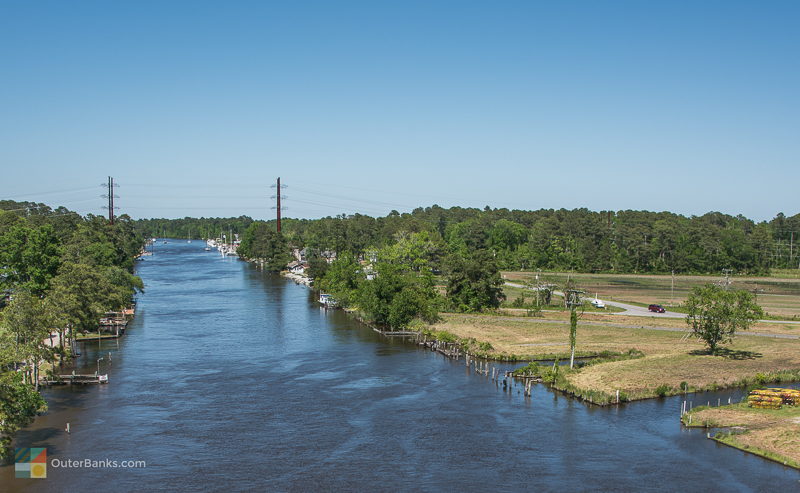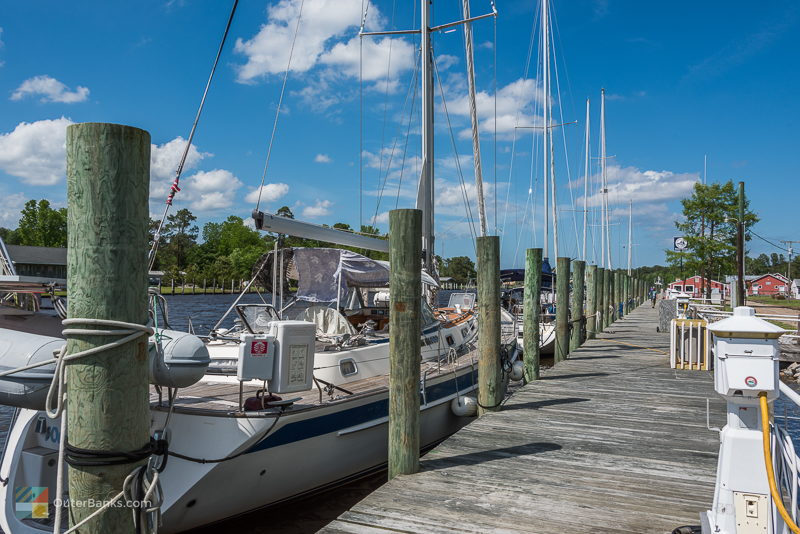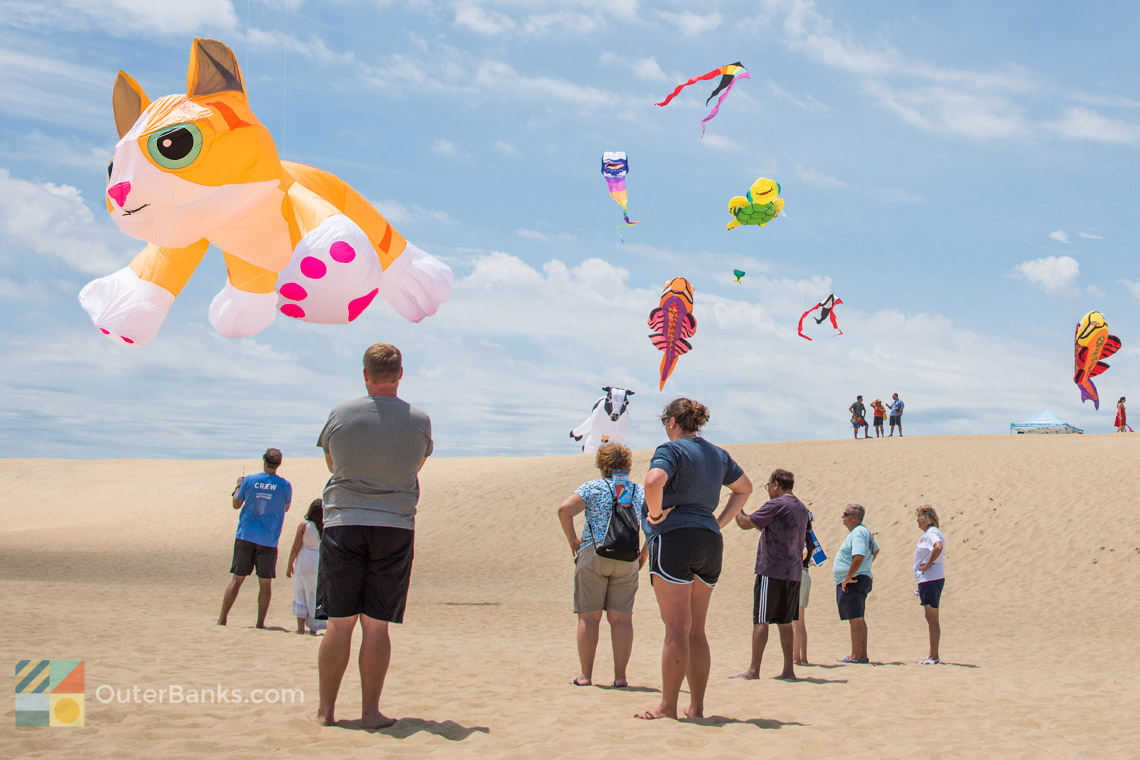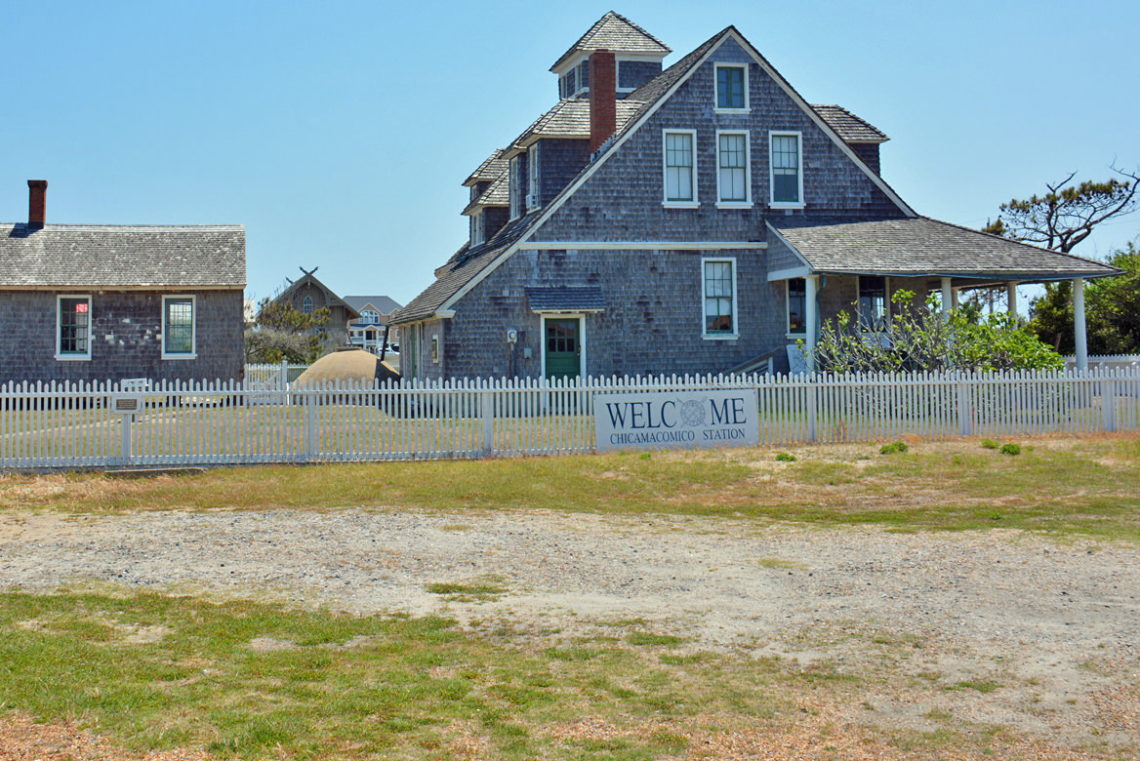Visitors to coastal North Carolina will most likely cross the Intracoastal Waterway during some portion of their expedition, and there's a good chance that they'll cross this massive water route multiple times. Extending all the way from the northern region of the country to the Gulf Coast, the waterway, which began as an essential trade route for shipping companies, is now more commonly used as a recreational trail for North Carolina sailors and boaters who want to explore the depth of the East Coast without straying too far from the Atlantic beaches.
The Outer Banks runs parallel to the waterway, and visitors who venture inland to explore the small towns of the Inner Banks will come in contact with the waterway on a regular basis. Lined with shops, marinas, and waterfront restaurants, and busy on warm summer days with maritime traffic in the middle of a 3,000 mile trip, or just local boaters out for an afternoon cruise, the Intracoastal Waterway is a unique portion of the Outer Banks region, and definitely worth a visit for maritime lovers of all varieties.

Geography of the Intracoastal Waterway
Nationally, the Intracoastal Waterway extends 3,000 miles from the heart of New York to the Gulf of America (formerly the Gulf of Mexico) facing beaches before trickling north, and is a significant portion of "America's Great Loop," an extensive waterway that literally loops from the East Coast to the Gulf of Mexico and then winds back up through the central states before hitting the Great Lakes region. Obviously, a cruise along the entirety of this waterway, which basically circles around half of the country, is an adventure best left to travelers with a few months on their hands and a love of cross-country travel.
Locally, North Carolina visitors who aren't on board for a 3,000 mile trip will find plenty of scenic portions of the Intracoastal Waterway that run through the state, often along the Outer and Inner Banks' backyards.
Along the Outer Banks, the waterway begins in northern Currituck County where it trickles south in two distinct routes: one that winds through the Great Dismal Swamp near Edenton and Elizabeth City and one route that is much wider and borders mainland Currituck County. These two routes combine in the Albemarle Sound, and for 20 or so miles, the Intracoastal Waterway turns into a wide-open parcel of soundfront until it connects to East Lake on the western edge of Dare County. From there, the waterway narrows significantly as it cuts through the mainland across Columbia and skirts past Tyrell County and the Lake Mattamuskeet National Wildlife Refuge.
The Intracoastal Waterway widens again as it joins with the open waters of the Pamlico Sound in Hyde County, and continues to hug the mainland coastline bordering the sound until it reaches Cedar Island, where it cuts across a marshy waterway into Beaufort and continues south down the coastline.
During the Intracoastal Waterway's route through the northern half of North Carolina, the waterway is always about 10-50 miles away from the Outer Banks. The route itself is incredibly diverse through all portions, sometimes consisting of a sail through miles of open sound water, and sometimes consisting of narrow waterways that are bordered by marshes, swamps or thick patches of dense forest. Essentially, mariners who travel just this small portion of Intracoastal Waterway, located parallel to the Outer Banks, will an enjoy a cross section of what the route in its 3,000 mile entirety is all about. With scenic views all around, and charming marinas, restaurants and shops located through the passage for the convenience of mariners, a simple trip exploring this Inner Banks region of the Intracoastal Waterway will certainly feel like an enjoyable, worldly adventure.
History of the Intracoastal Waterway
Even though the Intracoastal Waterway is relatively new by world history standards, being officially developed in the 1800s, the history of transporting goods along the Inner Banks is as old as the country itself. Beginning with the settlements along the Albemarle region and the Jamestown colony in Virginia, it soon became crystal clear that traders and shipping vessels needs an easier way to access multiple parts of the country that did not entail a long trip through the Atlantic Ocean. After all, as early as the 1500s, the massive and dangerous Diamond Shoals off the coast of the Outer Banks were already causing hundreds of shipwrecks a year, and an easier route was needed for both the safety of the ships regularly coming to ports along the East Coast, and to accommodate smaller vessels.
As early as the years following the American Revolution, plans were in the works to create a water connection between the villages and towns along northeaster North Carolina and Virginia, and in 1805, work began on digging and creating the Dismal Swamp canal, the older portion of the Intracoastal Waterway which runs through northern North Carolina and the Great Dismal Swamp. Completed in 1829, the canal was certainly a shortcut for many mariners, but unfortunately did not accommodate large vessels. A second, parallel canal, the Albemarle and Chesapeake Canal, was completed in 1859 to provide a wider route.
In the decades that followed, the US Army Corps of Engineers planned out various ways to create an effective trade route from Boston, MA to Beaufort, NC, and eventually submitted a proposal to the US Government to purchase certain stretches of land and marshlands, including the two 1800s canals, to create this extensive waterway. Congress agreed, and in 1913, work began on building the official "Inland Waterway from Norfolk, VA to Beaufort Inlet, NC." Most of the 120 mile stretch of waterway relied on the calmer sound waters of the Albemarle and Pamlico Sounds, however new routes had to be cut through Cedar Island, Hyde and Tyrell Counties to avoid shallow or treacherous portions, and to create an easier-to-travel waterway. The US Army Corps of Engineers also made improvements to the existing Dismal Swamp canal, making it wider and removing excess trees and decries that had grown up along the waterway in the past hundred years.
The Inland Waterway was complete by 1932, and by that point, the US Government was hard at work creating other watery routes to combine and create the entire Intracoastal Waterway.
While large cargo ships and some sailors still prefer to stick to the Atlantic Ocean coastline, the waterway effectively opened up a new route to smaller traders and shipping businesses, commercial fishermen, and recreational mariners, and is still enjoyed today as one of the most unique and scenic ways to take a "road trip" along the Carolina coastline.
Visiting the Intracoastal Waterway
Most visitors to the Outer Banks will only notice the Intracoastal Waterway via the road signs and bridges that are located en route to the Outer Banks.
Traveling from the north, visitors will cross over the Intracoastal Waterway on a small bridge on US 158 in Currituck County, and will run parallel to the waterway for the length of their trip down the mainland to the Wright Memorial Bridge to the Outer Banks.
Travelers from the western part of the state will have a much longer Intracoastal Waterway crossing at the nearly 5 mile Alligator River Bridge which stretches across East Lake, one of the wider portions of the Intracoastal Waterway. This bridge doubles as a draw bridge to accommodate larger vessels passing through along the waterway, and it's not unusual on a bright and sunny day for traffic to pause while the bridge opens and allows mariners cruising along the Intracoastal Waterway to pass through. When this happens, it presents a perfect opportunity to step out of the vehicle for a few minutes, enjoy a nice stretch and a little salt air, and take a good look around at the gorgeous waterway views.
Visitors from the south who head to the Outer Banks along the mainland via US 17 and US 264 will cross the waterway multiple times, through big and small bridges along Cedar Island and Hyde County. Regardless of which way you travel, however, keep a lookout for these sections of the Inner Banks where the roads cross paths with the Intracoastal Waterway. Often, a spectacular view can be found nearby in addition to some charming waterfront restaurants and marinas, and these intersections are almost always a nice spot to take a break from the road and have an exploratory look around.
If you want to explore the Intracoastal Waterway the way it was intended, by a skiff, boat, sailboat or even a kayak, there are plenty of marinas located throughout the Inner Banks that are happy to serve as launching grounds into the open waterway canals. Look for larger marinas and boat launches in bigger communities like Elizabeth City or Beaufort, or simply head to the small towns bordering the Intracoastal Waterway for quiet public launches directly into the water. In Dare County, the small town of East Lake has several private and public boat launches, and in Currituck Country, mariners will find a number of marinas and boat launches in Currituck close to Coinjock Bay.
You can also simply travel along US 158 through the length of Currituck County and take your pick of a number of Albemarle Sound facing beaches and boat launches that lead mariners directly to the large sound portions of the Intracoastal Waterway route. Essentially, any boater who cruises the Carolina Coastline along the Inner Banks will eventually come across multiple launching points, so all a boater has to do to get on board is to find a stretch they want to explore, load up the boat trailer, and start cruising.
Towns and Attractions Around the Intracoastal Waterway
While cruising through the Outer and Inner Banks sections of the Intracoastal Waterway, mariners will find plenty of towns and attractions that are worth a stop and a little exploration.
The towns along the Currituck County Mainland, specifically Currituck, Barco, Jarvisburg, Point Harbor ad Poplar Branch, are all unique mainland tourist destinations with locally acclaimed barbecue joints, fresh farmers' markets and vegetable stands, and a wide range of marinas and golf courses to explore For an overnight expedition of the outlying Outer Banks area, this northern region of North Carolina's Intracoastal Waterway is definitely worth a dock.
Further south past Dare County's East Lake, mariners will travel along the borders of a number of reserves and refuges, including the Pocosin Lakes National Wildlife Refuge, the Emily and Richardson Preyer Buckridge Coastal Reserve, and Mattamuskeet National Wildlife Refuge. Though any of these natural retreats are worth a look around, featuring wide areas of marshlands, maritime forests, and acres of rugged hunting and fishing grounds, perhaps the most popular of these three reserves is the area surrounding Lake Mattamuskeet. A popular spot for birders and fishermen alike, in the fall and winter months, Mattamuskeet becomes alive with thousands of migrating tundra swan who fill the lakes and marshes within the refuge and create a chorus of squawking and splashing that can be heard virtually anywhere within the park. An incredible site, on some days the entire lake literally looks like it's covered in snow as thousands of these impressively large white birds play in the water, paying no mind to the occasional human visitor.
Perhaps the most popular attraction along the Inner Banks, however, is the small town of Beaufort. Notorious for its reputation as a 1700s pirate haven, particularly for the Carolinas' most famous pirate Blackbeard himself, Beaufort is an inviting mix of small town coastal charm and vacation destination, with dozens of shops, restaurants, and historical attractions located right along the waterfront, including a North Carolina aquarium and a seashell museum.
In addition to these main attractions, mariners will also find a host of small restaurants and cafes with boat docks designed with Intracoastal Waterway travelers in mind, plenty of marinas and ship's stores to refuel on supplies and local maritime souvenirs, and miles of gorgeous waterway that is quiet, undeveloped, and miles away from the busy mainland towns located away from the water. The best way to find all these secret attractions and incredible views is to simply take out the boat and cruise, and mariners will be treated to incredible wildlife, fantastic waterfront sunsets, and charming coastal small towns as a reward for their Intracoastal Waterway travels.
Places to Stay Along the Intracoastal Waterway
While the 120 mile portion of the Outer and Inner Banks Intracoastal Waterway can certainly be covered in a day by an ambitious mariner, many travelers like to take things slow, and carve out the route over the course of a long weekend or an entire week. Thankfully, there are plenty of places to stay along the way, generally adjacent to the water so travelers can simply sail right in.
The small towns of Currituck County along the Chesapeake / Albemarle Route have a number of marinas that double as inns or bed and breakfasts. Often smaller with a handful of rooms available to passing vessels, these rooms are nonetheless accommodating, with boat slips, laundry facilities and convenience stores often located right on the premises, and are completely scenic. The best part about staying at an inn or B&B along the waterway, after all, is the open water view, and a number of these establishments have private porches and balconies overlooking the Albemarle Sound for relaxing water views on and off the boat.
Further south, travelers will find a handful of lodgings and inns available around Fairfield, near Lake Mattamuskeet, as well as a large number of campgrounds for a slightly rustic stay on dry land. With seasonal availability, (generally from spring to Thanksgiving), these accommodations may be rugged, but they provide a fantastic introduction to the salty wildlife that is found in abundance along the Inner Banks.
Many mariners enjoy staying in Cedar Island, and specifically Beaufort, located at the end of this coastal route. The small town has a half dozen inns located right on the waterfront with boat docks, charming and upscale accommodations, and a bevy of onsite amenities including hot tubs and community pools. With a central waterfront location that's within walking distance of Beaufort's best shops, restaurants and attractions, these accommodations are exceptionally popular with Intracoastal Waterway travelers from North Carolina and all along the East Coast.
Regardless of where you decide to drop anchor for a night or two, be sure and call well in advance to plan your stay. Many of these waterfront accommodations fill up fast with travelers of all genres, especially in the prime summer months, so it's best to make sure your reservations are secure before setting sail. Be sure and check for boat slip availability as well, in addition to proximity to any needed supplies, such as fuel stations and ships' stores.
Tips and Tricks for Traveling the Intracoastal Waterway
- Remember that you don't have to explore the entire length of the North Carolina waterway to have an enjoyable day on the water. Many locals and visitors, especially avid fishermen, stick to day trips around certain wider regions of the waterway for a scenic cruise, or some fantastic saltwater angling. Boat docks and launches along East Lake and the soundside communities along Currituck County are good places to start exploring, and the open waters of the Albemarle Sound are a fishermen's dream with a number of seasonal saltwater fish, like bass, flounder, blues, mullets and sheapshead, reeled in on a regular basis.
- If you run into trouble while en route, don't panic. The US Coast Guard has several stations set up along the route, including a major station in Elizabeth City, and several private boat towing companies like Boat US and Sea Tow are happy to service all areas of the Intracoastal Waterway for mariners who need a hand. Keep the local towing company numbers handy, and plan to travel on days with good weather and light winds, and you'll surely enjoy an Intracoastal Waterway exploration that's smooth sailing.
- Want to extend your coastal North Carolina travels? The Intracoastal Waterway runs all the way through the state, bordering the scenic regions of Wilmington and the Cape Fear Rivers before heading to South Carolina. Turn your weekend cruise into a full-fledged sailing adventure and continue past the Outer Banks to discover the entirety of the NC coastline.
- Want to explore the Intracoastal Waterway but don't have a boat? The waterfront restaurants located along the waterway are happy to welcome patrons with wheels instead of rudders, and there are a number of public parking areas available along the waterway for explorers who simply want to fish from the banks, or enjoy the view. In addition, the Outer Banks and Inner Banks have a number of watersports companies who can provide patrons with kayak rentals to explore the sound, or even fully-guided boat tours of the region. Look for local businesses that are close to where you're staying in the Outer Banks, and set off on your own waterfront adventure that will surely be a highlight of your vacation.
The Intracoastal Waterway began as an economical and safe route for businesses and shipping companies, but today it is equally appreciated by the thousands of annual visitors who take to the Outer and Inner Banks by boat. Whether your preferred method of travel is sailing, cruising, or even paddling, the 120 mile stretch of the Intracoastal Waterway that lies next to the Outer Banks is a scenic introduction to the coastal North Carolina landscape and lifestyle.
Plan a long weekend on the water exploring the entire length, or simply keep an eye out for those tell-tale road signs en route to your beach vacation. No matter how you choose to enjoy it, the Intracoastal Waterway is a fascinating way to explore the various, scenic aspects of the Outer Banks and Inner Banks life on the water.
-
Hatteras Island Oyster Roast
February 7th, 2026 1:00 PM - 4:00 PM -
First Friday in Manteo
March 6th, 2026 6:00 PM - 8:00 PM -
Hatteras Village Waterfowl Festival
March 6th, 2026 - March 7th, 2026
Serving our customers on the Outer Banks since 1994, Big Buck's ice Cream is dedicated serving you “The Best.” We offer a full line of super-premium ice cream products, smoothies, chocolates, and custom-made ice cream cakes! 2 locations...
Take a day trip or an afternoon off the beach to explore the heart of Historic Corolla Park, and you’ll find one of the Outer Banks’ newest and most noteworthy attractions, the Currituck Maritime Museum.
Now with Axe Throwing! Jumpmasters OBX is the ultimate trampoline park on the Outer Banks with attractions the entire family will enjoy. From open jump trampolines to the dodgeball court, 3-D climbing wall, a foam pit, an epic ninja obstacle course...
The Chicamacomico Lifesaving Station is one of Rodanthe's greatest treasures. This historical lifesaving station has been a popular attraction for Hatteras Island visitors for decades, and stands on the very edge of the small town of Rodanthe. Over...






